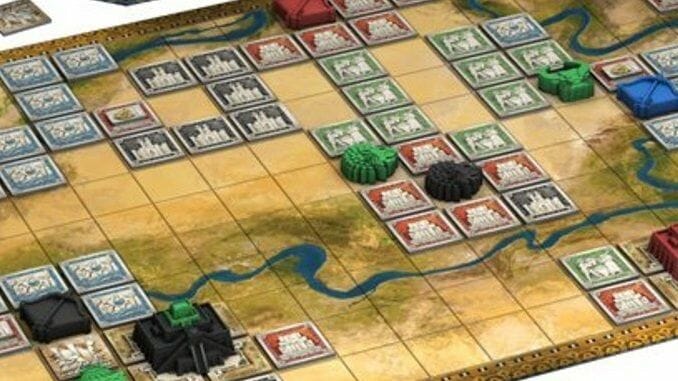
There are so many new board games published each year—well over 1000 debut in a typical cycle of game conventions, although we’ll see fewer than that in 2021—that it is inevitable that some older games, even popular ones, will slide out of print. Whether it’s distributors wishing to carry fewer SKUs, retailers lacking shelf space, or just consumers deciding that they don’t need to buy 50 new titles every year, some truly great games have slid out of print in the last 15 years. It’s not all bad news, as games do come back around; Pandasaurus brought Tammany Hall back last year, Great Western Trail is about to come out in a much-needed second edition, and Macao is coming back this year or early 2022 as Amsterdam. But there are still a ton of games that could use a new version, or just deserve to be back in print for new players to discover them. Here’s my ranking of the top 10 board games that are currently out of print.
10. Russian Railroads (2013)

One of BoardGameGeek’s top 100, not far behind our #9 El Grande, Russian Railroads is a heavy engine-building game where you try to build out three tracks for your railroad network while upgrading your locomotives, building factories, hiring workers, and more. As you build out your tracks, you unlock more benefits. It’s a game of long-range strategy with lots of options and decisions, and … it’s a train game, which is a perennial favorite genre, from Ticket to Ride to Age of Steam. It’s on the heavier side, good for fans of worker placement titles like Tzolk’in and Orléans, all games where you have tons of choices for your meeples and have to think over a long series of turns. Fortunately, you can play this one online at both Yucata and Board Game Arena.
9. El Grande (1995)

This is one of the highest-rated games on BoardGameGeek—which skews towards longer, heavier games—that is not currently in print, and it’s due not just for a new printing but for a fresh coat of paint. Designed by Wolfgang Kramer with Richard Ulrich, El Grande has players placing cubes representing “caballeros” on a map of Spain in the 1400s. The conceit is simple: You want to have the most cubes in each region for each of the game’s three scoring periods, which come after the third, sixth, and ninth rounds of placement. You start with some cubes in your court (your personal supply), and can gain more from the general pool, and get the right to place one or more from your court to the board based on which card you play in each round. You also get to take and use one action card per round, which might let you place more cubes, move an opponent’s cubes (or kick them off the board entirely), do a spontaneous scoring, or more. There’s also the “castillo,” sitting in the Mediterranean, where you can place cubes and then assign right before the next scoring. The most recent printing, in 2015, was a Big Box that included five expansions, and sells for $100+ on the secondary market.
8. Glory to Rome (2005)

This game has achieved cult status for multiple reasons, including the incredible number of combinations of cards players can play over the course of the game, and the fact that it is probably never going to come back into print. One co-designer tried to publish a second edition, and ended up losing his house in the process, leaving the industry for good after that. The other co-designer has released multiple games that re-use some of the mechanics of Glory to Rome, including Innovation, Uchronia, and Mottanai, with the latter two so similar to Glory to Rome that BoardGameGeek credits them as “reimplementations” (same game, different clothes, so to speak). He has refused to talk to the press about Glory to Rome, though. And the two co-designers don’t talk to each other. I’ll admit that I do not share the adulation for this game, or its descendants—I even had a copy of the original and sold it for a small profit because I realized it wasn’t for me. You have to really know what’s in the card deck to be good at it, which means playing it a lot, and the amateurish art of the first edition wasn’t helping matters. But if Glory to Rome came back into print, it would be the biggest tabletop story of the year.
7. Balloon Cup (2003)
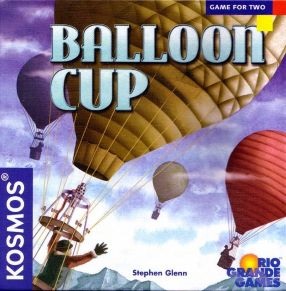
One of the most spiteful games I’ve ever played, Balloon Cup is a straight two-player game where players try to compete to gain control of four piles of cubes, coming in five different colors, and then trade them in to claim the game’s five balloons. Sometimes you get a pile if you have higher point values on the cards on your side, and sometimes you get the pile if your cards’ total value is lower. But the key here is that you can play cards to either side of the table. If lowest total wins a particular pile that has at least one grey cube in it, and you have a grey 13 card (the highest value), you can stick that on your opponents’ side and make it very hard for them to win the pile. There’s nothing more aggravating than having someone do that when you were about to play a much better card to that same space. It’s a good thing I have only played this online because this game seems like it would lead to violence. A new version that played up to four players with a new theme and several significant rule changes was published as Piñata, but the consensus among those who know the original is that it’s not the same game. Used copies of Balloon Cup go for well over $100 now, so some publisher is missing out on easy money here.
6. Glen More (2010)
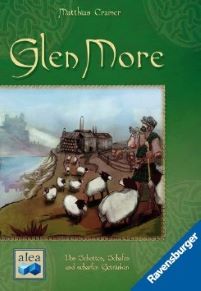
The first title from Matthias Cramer, who later designed the wonderful two-player game Watergate, Glen More is a great midweight game of resource management, tile placement, and whiskey distilling. You take tiles from a rondel on a central board and use them to build out your village, following a series of placement rules, and then activate the new tile and everything adjacent to it, gaining resources, actions, or points. One major way to earn points over the course of the game’s three scorings is by distilling more whiskey than your opponents—but if your village is too big, you lose three points per tile over the minimum. The game was reimplemented in 2019 as the massive Glen More II: Chronicles, but that game doubled the playing time, only plays 2-4 players instead of 2-5, and added a bunch of needless complexity. Whiskey makes the world go round twice as fast, so why make a game about whiskey take twice as long?
5. Thurn und Taxis (2006)
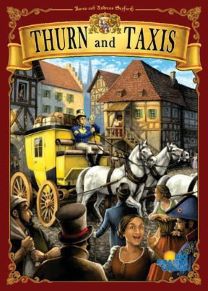
A Spiel des Jahres winner when it was first released, Thurn und Taxis is one of the games I’ve played the most times between the physical game and online play, to the point where I’m kind of over it… but the fact that I played it this much is a good argument for a reprint. Players try to build out their own postal routes on a map of central Germany (which might limit the game’s appeal somewhat), drawing city cards from a central market that always has six cards in it, closing routes once they have at least three connected cities. The heart of the game is the bonus cards—there are bonuses for building in each of the game’s five regions, for building in all ten areas, and for building routes of increasing length, from three to seven. There are two dominant strategies that I can see for two-player games, but with more players the city card deck moves more often and boosts the luck element. It’s a great introduction to route-building games, and the way to success in Thurn und Taxis is to think about efficiency, which seems like a good life skill.
4. Orient Express (1985)
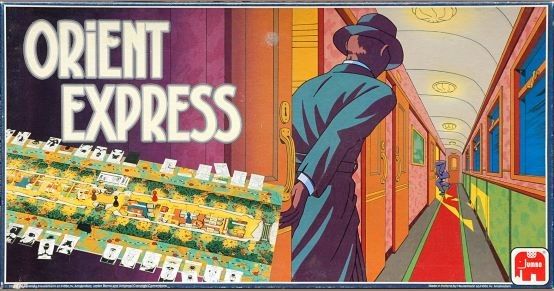
A personal favorite of mine since I was in middle school, Orient Express takes those logic puzzles you see in airport magazines—Alice, Bob, Carol, Dave, and Englebert each have different jobs, and different hats, and you have to figure out who has what—and turns it into a murder mystery board game. You move your detective around the train, interviewing suspects and crew members, searching locations, and, when the train stops at certain stations, sending telegrams (à la Hercule Poirot) to gather more information—but the train also moves on certain rolls of the dice, so you’re not just racing against your opponents but against the clock. You could also slap secrecy tokens on certain people or rooms to make it harder for other players to get those clues—even if the clue itself was useless and you just wanted to set up a decoy. The original game came with 20 cases and at least 20 more were published as an expansion, but it’s never seen a fresh printing.
3. Tigris & Euphrates (1997)
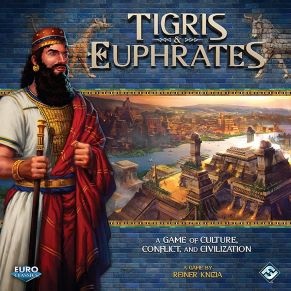
When Fantasy Flight reprinted this a few years ago, they rethought all the cosmetic stuff—the packaging, the colors, the components—but left the core game intact, which is great, as it’s one of Reiner Knizia’s finest titles. Each player has four “king” tiles in the game’s four colors, and may place them on the map, which has two rivers representing the two famous rivers (and really nothing else tied to ancient Mesopotamia). Players place square tokens of four colors on the map adjacent to their kings to control larger areas, but when two kingdoms connect, war breaks out; you can add more tokens from your hand, after which each players’ tiles are counted by color, and only the player with the most tiles of each color gets to leave their king on the board. You can also build two-colored monuments that produce points on each turn when your king of either color is in the same kingdom. The real catch is that you accumulate points separately for each of the four colors, and at the end of the game, you compare your lowest point total to that of the other players—so balance is key. From 2008 onward, all printings included a two-sided board with a more advanced map and the Wonder (also called the Ziggurat) expansion. The Fantasy Flight reprint was the best version yet, but it’s back out of print with the rest of the Euro Classics series. Knizia himself remade this as a new game, Yellow & Yangtze, which switched from square tiles to hexes, created a fifth “kingdom” that counts as a wild color in final scoring, and got a great digital adaptation from Dire Wolf. You could buy that and get most of the Tigris experience, but the original is still the best.
2. Jambo (2004)

A great two-player game from Rudiger Dorn (Istanbul, Luxor), Jambo’s been out of print for years now, which is a shame because two-player games with strong interaction and simple rules are always in demand. Players try to buy and sell six different goods, but everything in the game is done via cards that you draw one by one and that allow you the chance to buy or sell goods, gain permanent new powers, expand your storage, or get one-time benefits. You have five action points to use on each turn, and use one to draw a card from the deck which you can keep, or discard, spending another point if you want to draw a new card. Cards that show goods let you buy them at one price or sell the same goods at a higher price. You spend points to play cards from your hand, or to activate any of your permanent utility cards—but beware, as your opponent can play the Crocodile and discard one of your utility cards, but only after they use its power once for themselves. The goal is to be the first player to amass 60 gold from selling your wares. There was a Dutch reprinting in 2015, but nothing in English since the original. This might be good for a retheme, however; there’s nothing inherently wrong with Jambo but rising awareness of cultural appropriation does make a theme of traditional African traders designed by a white man in Germany with art by a different white man in Germany seem a bit unnecessary.
1. Samurai (1998)
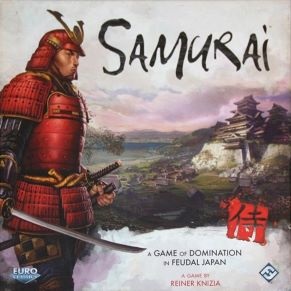
Samurai did get a second printing, with new art and a smaller box, as part of Fantasy Flight Games’ Euro Classics series, but they’ve sunsetted that product line, even cancelled a planned reprint of Princes of Florence, so Samurai, Tigris & Euphrates, Ra, and Through the Desert, all designed by the prolific Reiner Knizia, have all lapsed back into out-of-print status. Samurai is Knizia at his best, and a genius design that has very little luck and plays extremely well with two players, three, or four. Players try to place their tokens on a hex map of Japan that has three types of landmarks on it—samurai warriors, peasants, and priests—that they can control by having the most powerful matching tokens around it. Most tokens show warriors, peasants, or priests, plus a value from 1 to 4, but you also have wild card tokens, ships that can only be played on water hexes, and three sneaky tokens with extra powers: the Ronin, a wild card token that can be played as an extra action and is worth +1 to your other tokens around that landmark; the token exchange piece, that lets you move a token you’ve already placed to an empty hex; and the figure exchange, that lets you switch two landmarks, the most dastardly move of all. You win by capturing the majority of any two of the three kinds of landmark figures, or, if no one does so, then by capturing the majority of one type and then having the most additional captured figures. You have to think about what your opponents have yet to play while also considering where to use your most valuable tiles. It’s genius, and while there are a good number of used copies out there, it should never be out of print entirely.
Honorable mentions: Tobago, Through the Desert, Medici, Ra, Forged in Steel, Reef Encounter, Saint Petersburg.
Keith Law is the author of The Inside Game and Smart Baseball and a senior baseball writer for The Athletic. You can find his personal blog the dish, covering games, literature, and more, at meadowparty.com/blog.